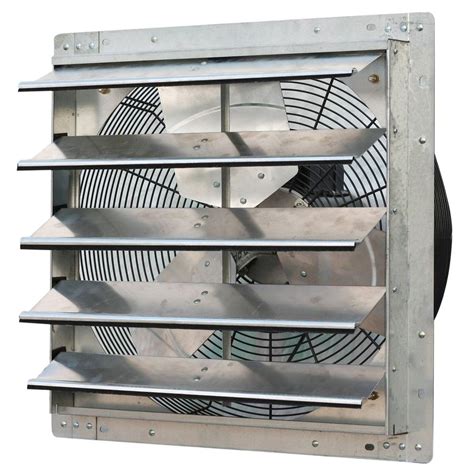Why do I need to know about shed ventilation?
If you are building a shed or already own a shed you need to know your shed ventilation options for many reasons. You need to need to make sure you shed has good air flow for health reasons. The contents in your shed need good ventilation for proper storage. The shed may get too damp and the shed itself could rot and disintegrate. If the shed boards begin to rot, then it could eventually lead to the shed being torn down.
Shed Ventilation – Health Reasons
 If your shed is not properly ventilated, then you could run the risk of developing mold throughout your shed. Mold is a fungus that grows in wet environments via spores. According to the Centers For Disease Control (CDC) mold can cause a variety of health effects for certain people while others are not affected at all.
If your shed is not properly ventilated, then you could run the risk of developing mold throughout your shed. Mold is a fungus that grows in wet environments via spores. According to the Centers For Disease Control (CDC) mold can cause a variety of health effects for certain people while others are not affected at all.
The common symptoms are nasal stuffiness, throat irritation, coughing or wheezing, eye and skin irritation. However, more serious reactions can occur in people with mold allergies or chronic illnesses. They can get serious infections in their lungs when they are exposed to mold. Read the full report from the CDC and you will know why you need proper ventilation for health reasons. Full report from the CDC.
If your shed already has mold, then there are certain things you can do to get rid of the mold. Also, there are other options for prevention of mold and treatment of mold. Check out my previous post on Shed Mold & Mildew.
Shed Ventilation – Structural Reasons

If your shed is not properly ventilated, then you can develop standing water or increased humidity in your shed. Prolonged exposure of the wood to water can cause mold as noted above. However, if this water stays on the wood for a longer period of time it will cause damage to the wood itself.
Shed Ventilation – Wood Damage
This damage will cause a breakdown of the wood fibers and over time it will cause the wood to rot. Once the wood starts to develop rot, then the stability of the wood will be in question. Once the stability of the wood becomes weak you run the risk of the entire shed to be damaged.
Therefore you can see the importance of shed ventilation to prevent high humidity levels inside your shed and subsequent damage. Proper ventilation in your shed will protect the wood from rotting. It will also protect you from one day having to tear down your shed.
Poor ventilation in a shed can lead to various consequences such as the build-up of mildew and moss, particularly during cooler months when windows are not frequently opened. Inadequate airflow can also result in the accumulation of harmful substances like chemicals, fuel, oils, paints, and paint thinners. This can not only cause health issues for individuals working inside the shed but can also contribute to the development of mildew and mold. Therefore, ensuring proper ventilation inside a shed is crucial to prevent these negative outcomes and maintain a healthy environment for storage and other activities.
Shed Ventilation Types – Roof Options
Turbine Vent or Whirlybird
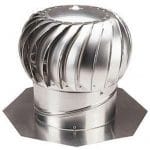 Whirlybird roof vents or turbine air vents provide additional airflow inside a garden shed to enhance ventilation. When a slight breeze enters the turbine, it activates and starts extracting hot air from the shed. This process creates a flow of cooler air that enters from the lower areas of the shed, replacing the hot air. Turbines are particularly beneficial for sheds prone to mildew due to excess moisture or sheds where chemicals are regularly used, as they effectively mitigate condensation issues by maintaining a consistent airflow.
Whirlybird roof vents or turbine air vents provide additional airflow inside a garden shed to enhance ventilation. When a slight breeze enters the turbine, it activates and starts extracting hot air from the shed. This process creates a flow of cooler air that enters from the lower areas of the shed, replacing the hot air. Turbines are particularly beneficial for sheds prone to mildew due to excess moisture or sheds where chemicals are regularly used, as they effectively mitigate condensation issues by maintaining a consistent airflow.
A turbine vent is installed on top of the roof and forces hot air out of the shed. It is a rounded structure that has spinning blades. These blades will force the hot air inside of your shed out to the environment. Most research on the effectiveness of these vents have been done with attics.
Turbine Vent Research
One study revealed that over a 12 hour testing window the turbine vent lowered the attic temperature from 123°F to 113°F. This study also revealed that the turbine vent lowered the temperature of the roof deck materials from 146°F to 124°F. With the turbine fan spinning at 5 miles per hour it can move 347 cubic feet of air from the attic. If the speed increases, then it can move a lot more air. These are easy to install and can ventilate your shed rather easily. It is best used for medium to large sheds and not really smaller sheds as it tends to move a lot of air.
Turbine vent installation.
Find The Area
Find the area where you want to install the turbine vent from the inside of the shed. Make sure the area of installation is between two rafters. Drill a hole through the ceiling plyboard from the inside as it will go through the plyboard and through the shingle so you can locate the area on top of the shed.
Mark & Install The Base
Once you have the location of the vent marked you will then place the outline of the vent or flashing over the hole. Take a marker and trace the diameter of the vent so you can then cut out that area for the vent. Then slide the flashing under the shingles and make sure the diameter of the vent is equal to the hole that was cut. Secure the flashing to the roof with some nails. You can caulk around the flashing to make sure the flashing has a watertight seal.
Install The Whirlybird Fan
Line the base of the turbine vent to the flashing according the the pitch of the roof. This will make the turbine vent level. Then fasten the base to the flashing so you can install the turbine vent to the base with the appropriate screws. Make sure the turbine is level and it will spin and ventilate the shed.
Vented Skylight
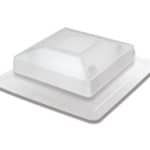 A venting skylight will add some sunlight into your shed as well as hot air to be removed from your shed. The basic installation is as below but can be different depending on the skylight you purchase. So make sure you read the instructions for proper installation below. This type of ventilation is best used for smaller sheds. However, if you have a larger shed, then you can look at a larger skylight or multiple skylights.
A venting skylight will add some sunlight into your shed as well as hot air to be removed from your shed. The basic installation is as below but can be different depending on the skylight you purchase. So make sure you read the instructions for proper installation below. This type of ventilation is best used for smaller sheds. However, if you have a larger shed, then you can look at a larger skylight or multiple skylights.
Automatic and Manual Vented Skylights
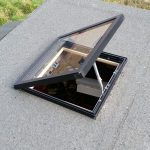 There are many different options with a venting skylight as some of the skylights can be automatic open or manual open. There is a solar powered skylight too. The automatic skylights will open and shut depending on the heat and the need for ventilation.
There are many different options with a venting skylight as some of the skylights can be automatic open or manual open. There is a solar powered skylight too. The automatic skylights will open and shut depending on the heat and the need for ventilation.
Some of the automatic vents may require electricity or power and can be done with solar power. However, other automatic vents will have cylinders filled with gas that expand depending on the temperatures. This will open and shut the skylight accordingly. The manual vents are a good option as long as they are accessible for ease of opening.
Vented Skylight Installation
To install the skylight you need to find the correct area for your installation in your shed. Mark the area with an outline of the vent. Then cut out the shape of the skylight. Once the area is cutout then install the frame for the skylight. Depending on the skylight it can be either small or large.
Once the frame is in place you will need to make sure it has a watertight seal. This is done with a membrane that sticks to the frame. Then replace shingles around the frame. Depending on your skylight there are many different variations for installation so make sure you read the instructions carefully. Velux makes a great skylight and here are the typical installation instructions from their website. I found this video also.
Ridge Vents
A ridge vent is installed at the peak of the shed roof for shed ventilation. The apex of the roof will have an opening and the ridge vent will be installed at the apex. The ridge vent will allow air to escape from the inside of the shed and ventilate the shed.
It is important to install the ridge vents in a straight line along the apex of the roof. Typically it is recommended to place a level chalk line and then secure one side of the ridge vent and or slope at a time. This will allow the ridge vent to be installed level and is secured with nails. Do not drive the nails in too far or it will cause the vent to buckle. Once the vent is installed then you will install the ridge vent shingles for the cap. Above is a nice video explaining the ridge vents and installation.
Cupola
Cupolas are nice option for shed ventilation. They are typically used for larger sheds because of their size. They also can move a lot of air because of their size. To begin you need to choose the right size cupola for the shed. The typical calculation is 1.5 inches of cupola width for every foot of uninterrupted roof line.
Find The Area
The basic installation is to mark where you want the cupola placed and make sure it is between rafters. For ventilation you will need to cut an opening in the roof leaving a 5-6″ minimum around the inside perimeter of the cupola base. This will allow you to have enough room to fasten the cupola to the roof.
Mark The Area
Measure the exact roof pitch so you can cut the cupola base so it will sit securely on your roof and at the right pitch. You will then install 2×4 to the inside of the base and secure them to the roof. Fasten the base to the 2x4s as this will secure the base in place.
Install The Cupola
Caulk the outside of the base to make a watertight seal. Now it is time to place the midsection of the cupola to the base and then the top onto the midsection. Many manufacturers will have the installation manual online. The video below has a nice stepwise approach to the installation.
Cupolas are very neat vents as you can get quite creative with your cupola design to make your shed stand out.
Shed Ventilation – Wall options
Windows
Having windows in a shed promotes ventilation by allowing fresh air to circulate inside the space. This increased airflow helps in controlling temperature and preventing the build-up of moisture which can lead to issues like mold and mildew. Additionally, windows provide natural light, reducing the need for artificial lighting during the day and creating a more pleasant working environment. Furthermore, the presence of windows enhances the shed’s aesthetics, adding a touch of charm and making the overall structure more visually appealing.
Gable Louver vents.
These are nice looking vents that can be different shapes. Most are round or square but can be triangular also. The typical size of the vent is determined by the 1 to 150 rule For every 150- square feet of space equals to 1 inch of ventilation. However, you need to check your local building codes as this can change depending on your area.
Installation is relatively simple as you will have to cut out the size of the vent from the wall. Like the other ventilation types you will need to make the cutout from the inside of the shed so you can make sure you are not cutting into any electrical cords or rafters. Then secure the vent to the wall and make sure it is secure and caulked for a watertight seal. Some vents will have an inside and outside piece that will need to be secured together. So you may need two people to do the installation. This is a nice video review of a simple installation.
Solar Powered Gable Vents & Fans
These are great options for a powered fan that runs on solar power and not with your electricity. Once installed you can put your mind at ease as the fan will run with the solar power and ventilate your shed nicely. It will typically be used for larger sheds but that really depends on the size of the fan you purchase. Installation is easy as noted in this video. There are many options available from many different manufacturers so check them out and read the reviews.
Powered Wall Vents
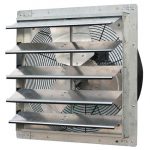 A powered wall vent is a nice option provided you have electricity run to your shed. However, they can be solar powered also. They will install very similar to the louver vent but there will be a power option to move significant amounts of air out of the shed and provide for adequate ventilation. This is a good option if you are going to do work in your shed that would require painting or fumes as it can ventilate the shed to a greater degree than other options.
A powered wall vent is a nice option provided you have electricity run to your shed. However, they can be solar powered also. They will install very similar to the louver vent but there will be a power option to move significant amounts of air out of the shed and provide for adequate ventilation. This is a good option if you are going to do work in your shed that would require painting or fumes as it can ventilate the shed to a greater degree than other options.
Installation is somewhat simple in that it will be installed very similar to a louver event, but electricity will need to be run to the powered wall vent. Lomanco makes great wall vents and their website has instructions in pdf format for all of their installations.
Shed Ventilation Accessories.
Various accessories can be utilized to enhance ventilation in sheds. Some effective options include wall vents, ridge vents, vented skylights, windows, whirlybirds, turbine air vents, ceiling fans, and small fans. Wall vents facilitate the flow of fresh air in and out of the shed, while ridge vents, located at the peak of sloped roofs, allow hot air to escape. Vented skylights offer a combination of natural light and air circulation. Windows not only provide additional daylight but also contribute to proper airflow. For enhanced ventilation, options such as whirlybirds, turbine air vents, ceiling fans, and small fans can be installed inside the shed. Each of these accessories plays a key role in ensuring adequate air circulation, which is essential for maintaining a healthy and comfortable environment within the shed.
Shed Ventilation Conclusion
If you are building a shed or already own a shed you need to know your shed ventilation options for health and structural reasons. You have many options for ventilation as you can have a simple vent or more elaborate options that include fans and electricity. The right shed ventilation will depend on the purpose and size of your shed. Proper ventilation will protect your shed from rotting and can protect your health so make the right choice for your shed.
All the best,
JB

